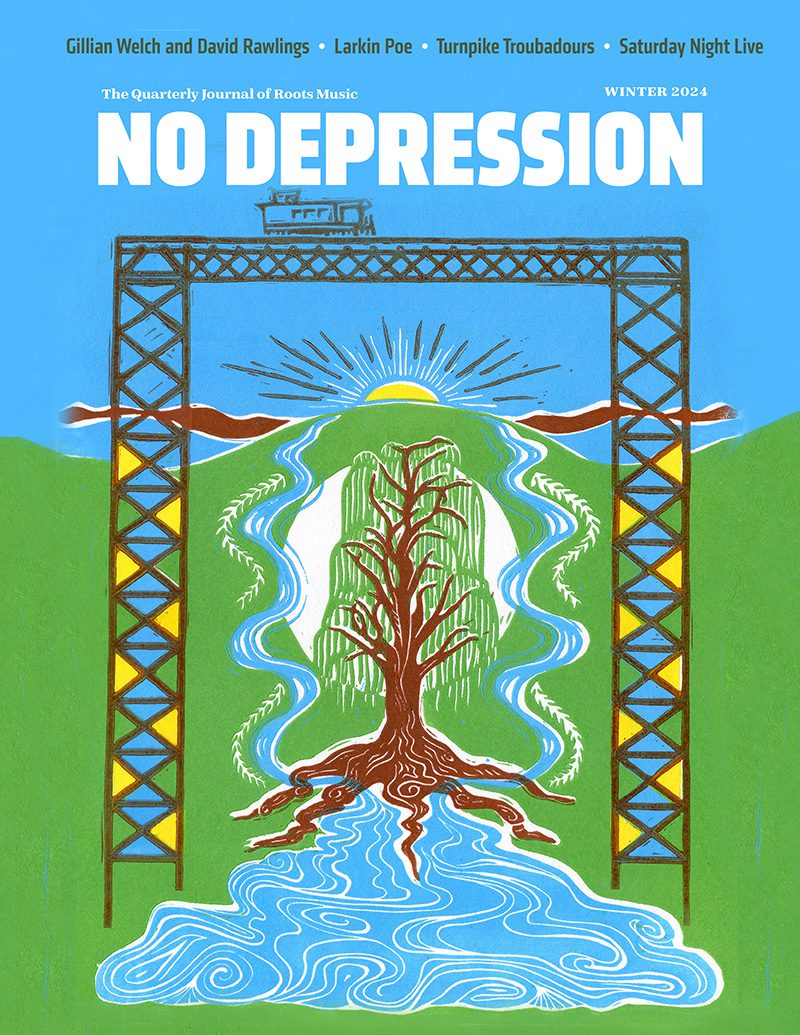Tricia Spencer – Fiddlin’ Like There’s No Tomorrow
The headline could read, “Prairie Fiddler with a Mountain Heart” regarding Tricia Spencer and her first solo recording, “Fiddlin’ Like There’s No Tomorrow“. In a recent interview Tricia remarked that she hopes someday, to live in the mountains where she first realized her passion for old time fiddling. That passion has resulted in her first solo effort, a wonderful, soulful collection of twenty old time tunes, mostly fiddle and the rest Carter Family style traditionals except for one original composition, track 10, “Snappin Jack”, and another composed by a friend, Mark Ward, track 16, “Willie and Mary’s Waltz”. “Single Girl, Married Girl” features back-up harmonies by acclaimed musician/singer Cindy Novelo. Together, they re-create the simple, but haunting textures of this popular mountain tune about youthful marriage angst.
The album opens by taking you back in the deep woods with a haunting fiddle/banjo version of “The Cuckoo”. Mark Ward plays banjo here and accompanies Tricia on several more tracks. Tricia included top notch old time musicians on this cd including young, but legendary, Betse Ellis. It was after competing in a contest in 2002, that she met fiddler Betse Ellis, of the Wilders fame. Betse told her, “You’re a pretty good fiddler. You should be in a band.” Tricia became the fiddler and vocalist for the Prairie Acre, a highly acclaimed mid-western bluegrass band. She and Betse have been friends ever since. Betse contributes cello and harmony vocal on “The Blackest Crow”, track 8.
Tricia says, “My idea was to ask everyone who had influenced me over those years to play on this album. I love playing with a band and experiencing that amazing groove but I also love the simplicity of sharing tunes with people.” Tricia also included her 13 year old daughter, Josie on bass, and her mother Pat Payne, on guitar for a festival jam feel on track 7, “Tomahawk”.
Tricia’s selection of twenty tunes is the result of her full immersion into Old Time music. She’s been seriously exploring this rich traditional music since around 2008 but she has been “Fiddlin’ Like There’s No Tomorrow” in learning so many tunes and tunings. My personal favorite here is track 18, “44 Gun”. This song best represents the full gamut of old time. Tricia starts this tale of scorn with the high lonesome fiddle reminiscent of old time fiddling icon,the late Tommy Jarrell. Her vocals here are pure mountain, nothing pretentious, just a fiddling lady feeling the story. She drops down in the lower register completing the scorn to mourn story of lost love.
She also does a knockout version of “Cotton Eyed Joe.” I thought I’d heard about all the tunes with this name but Tricia credits this version to Illinois fiddler, Noah Beavers. Cotton Eyed Joe must have really gotten around to have so many tunes both instrumental and lyrical written about him, whoever he really was.
I was able to interview Tricia recently and ask a few questions about her and her music.
Tricia grew up in the country in a little town called Big Springs located between Lawrence and Topeka, KS.
She comes from a long line of fiddlers. She says she was prepped to be a fiddler while still in the womb.
“My mama was pregnant and playing with The Spencer Family band: my grandpa playing fiddle, grandma playing guitar and mandolin, my dad playing guitar and banjo and my mama playing bass. My mama will often jokingly say, ‘yep, that little girl sucked the talent out each and everyone of us.’ At the age of three, my family decided to enroll me in Suzuki classes. After a few months, I stopped the lessons and started learning from my grandma instead. She seemed to have an abundance of patience when it came to listening to someone play so horribly. She taught me the G scale, double notes and a couple of standard beginner fiddle tunes — “Twinkle Twinkle Little Star” and “Mary Had A Little Lamb.” The photo to the right is Tricia, lower right, with her grandparents.
Tricia honed her craft as a youngster, entering and winning fiddle contests. She took some time off to go to college, get married and become a mother of two. She travelled to the Indiana Fiddler’s Convention in 2007 and fell in love with old time fiddling. Tricia says, “I fell in love with these new tunes and this type of festival session playing. I began traveling with my kids and my mama to other festivals and meeting many talented musicians who were willing to share their tunes and knowledge. I became obsessed with learning and studying source recordings of these old-time fiddlers like Clyde Davenport, John Salyer, Buddy Thomas, The Skillet Lickers, Ed Haley, The Carter Family, Ernie Carpenter, JP Fraley, and the list goes on and on.”

TS-“I had to do a lot of listening and just realize something different was actually happening. Some of the early tunes that I had learned more in the Appalachian style still sounded like tunes played by a bluegrass fiddler. By sitting in jams for the past five years, and watching what I was hearing, allowed me to figure out some of the bow patterns. I was fortunate to have a great friend that was interested as well and had spent time doing the same thing. This is still a work in progress as there are nuances that I hear but can’t create yet.”
EH-Old time fiddlers use a variety of tunings but why? What determines what tuning you will use when you learn an old time tune?
TS-“Growing up in the region that I did, I was never exposed to alternate tunings except for when I learned Midnight on the Water. I had heard of the “Black Mountain Rag” tuning (calico) but only knew of the one tune so I never messed with it. My first old-time fiddle festival in 2008 at Indiana Fiddler’s Gathering, I was shocked to find out that the fiddler’s would spend days in cross tuning. It prompted me to go home and learn tunes so I could jam in that tuning for a couple of hours. I can’t tell you how many tunes I learned in standard to find out later that they were normally played in a cross tuning. This further led me to learn about a D tuning and now I mess around with different tunings to compliment my voice or the tune itself. I listen to the source fiddler first and figure out how it was played in the early days. If it is a tune I sing, I will leave it but may lower the pitch. (The cross tunes are fun to do this with either AEAE, GDGD, or FCFC. It is hard to go much lower.) I may change it so that I can sing in my register.”
EH-Tell me about your favorite fiddle and why you prefer the bow you use.
TS-“My Grandpa was an old-time fiddler from Douglas County in Kansas. I grew up listening to him play with my Grandma and Dad. Grandpa collected fiddles like he did fiddle tunes, and by the time I was old enough to start picking my instrument, he had collected around 70 fiddles. They were stored in various places of his house and in a broken down meat case in his gas station. My first “real” fiddle was an old Stainer copy with a couple of top cracks and an already wore fingerboard. I was in middle school when I picked this one out and played it until his death in 1993. When he passed away, my Grandma allowed me to keep in my possession his 2 favorite fiddles. His favorite, which he used around the house and for contest fiddling is an old German conservatory fiddle which is my primary instrument. His second fiddle, which is my second fiddle, is another old German fiddle which he used to keep on the wall at the gas station and take down when folks came in to play with him. This second fiddle received some unusual attention from my Grandpa. He used to put the stickers he got from the Cracker Jack boxes on the ribs of this fiddle. I should have left them on there. Every now and then, I am in awe of my 2 fiddles. They have played so many tunes and have been held by so many different folks. The fact that my Grandpa played his tunes on these fiddles, the same tunes that inspired me to play in my youth, I don’t think I will ever find another fiddle that can replace either of these.”
EH-I like your original tune, “Snappin’ Jack”. As for composing, how do you approach that?
TS-“Normally a theme comes to mind and I can’t make it leave. Once that happens, I sit and work the phrases around a certain theme. I may be naive about this, but I assume anything I create is borrowed from something I have heard somewhere else. I just keep working with it and hope that due to my own individuality, it will be different enough to call it my own.”
I think that’s a fair description of what happens when every note you’ve ever heard in your life mulls and bumps and rests and moves, then re-assembles itself randomly as an original tune. “Fiddlin’ Like There’s No Tomorrow” is a pure example of Americana/Roots Music being preserved, embellished and passed on in the American Folk Tradition. If you love Old Time Music or you’re just curious, this is a great album to have. Tricia spared no details in production either. The album is a front to back gallery of earthy art. She adds complete notes about the folks helping her out and she also lists the tuning and her history of each of the twenty songs on the album. When Tricia Spencer is not performing solo or with her band, The Prairie Acre, she repairs and sell violins at Beautiful Music Violin Shop in Lawrence, KS. You can hear her music, see her videos, get her concert schedule and learn more about her, and purchase her first solo CD, “Fiddlin’ Like There’s No Tomorrow” at her website, http://triciaspencer.com
Ernie Hill





